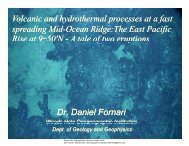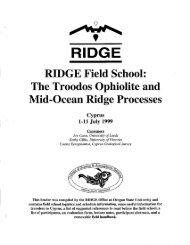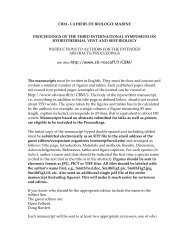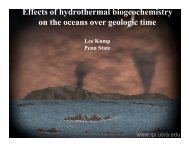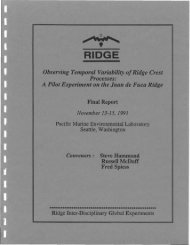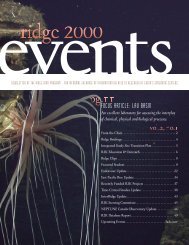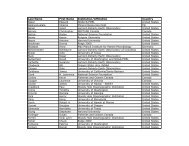Create successful ePaper yourself
Turn your PDF publications into a flip-book with our unique Google optimized e-Paper software.
GROUP 1:<br />
MANTLE DYNAMICS: MAGMA GENERATION AND DELIVERY<br />
Members:<br />
Donald Forsyth. Co-Chairman<br />
John Whitehead. Co-Chairman<br />
Roger Buck. Charles Cox. Roger Denlinger. Henry Dick.<br />
Michael Gurnis. Adolphe Nicolas. John Orcutt.<br />
Jason Phipps Morgan. and Sean Solomon<br />
Scientific Rationale<br />
Pressure-release melting of upwelling mantle beneath a<br />
spreading center is the primary process by which magma is<br />
generated. The depth and degree of partial melting beneath the<br />
ridge is controlled by the rate of upwelling and the composition<br />
and temperature of the mantle. The spatial and temporal<br />
distribution of melting thus reflects the dynamics of mantle<br />
flow. Although some constraints on the pressure and temperature<br />
conditions of melt formation are provided by petrological<br />
studies. the physical processes which control magma generation<br />
and delivery. and their chemical consequences. are poorly<br />
understood.<br />
The primary scientific objective in the study of mantle<br />
dynamics at spreading centers is to understand the flow of the<br />
mantle. the generation of melt. and the transport of magmas<br />
beneath ridge systems. Separation of melt from residual mantle<br />
will control the redistribution and chemical stratification of<br />
mantle materials. the structure of young oceanic plates. the<br />
rate and geometry of melt delivery to the base of the crust. and<br />
the composition of parental melts emplaced in crustal magma<br />
bodies. Understanding these mechanisms is important for a broad<br />
range of topics. including the nature of mantle heterogeneity.<br />
the spatial and temporal variations in crustal morphology.<br />
structure. and composition. and segmentation of the ridge crest.<br />
Investigation of this problem can be separated into two<br />
questions: (1) what is the pattern of mantle flow and melt<br />
generation beneath a spreading center? and (2) how does melt<br />
segregate from the mantle and migrate to the base of the crust?<br />
The answers to these questions will require coordinated.<br />
interdisciplinary observational. laboratory. and theoretical<br />
efforts. In addition. understanding of the behavior of the<br />
upper mantle revealed by ophiolite studies is of great<br />
importance.<br />
14






